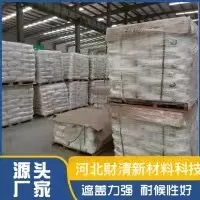
Th8 . 11, 2025 17:10 Trở lại danh sách
How Titanium Dioxide Makes Your Exterior Wall Color More Durable and Non-Fading
titan dioxit (TiO₂) is a cornerstone of modern exterior paints and coatings, renowned for its ability to enhance color durability and resist fading. As a highly effective white pigment, titanium dioxide powder is widely used in architectural paints to provide opacity, brightness, and long-lasting protection against environmental factors. Whether in residential homes or commercial buildings, titanium dioxide coating ensures that exterior walls maintain their vibrant appearance for years, even under harsh sunlight and weathering.

Why Titanium Dioxide Pigment is Essential for Exterior Paints
Exterior walls are constantly exposed to sunlight, rain, pollution, and temperature fluctuations, all of which can degrade conventional paint formulations. Titanium dioxide paint stands out due to the unique properties of TiO₂, which include:
1. Superior UV Resistance for Non-Fading Color
One of the biggest challenges in exterior coatings is preventing color fading caused by ultraviolet (UV) radiation. Titanium dioxide color stability comes from its ability to absorb and scatter UV light, protecting the underlying paint film and organic pigments from degradation. Unlike other white pigments, TiO₂ does not yellow or chalk over time, ensuring that the wall color remains true for decades.
2. High Opacity for Better Coverage and Durability
The refractive index of titanium dioxide powder (2.7 for rutile TiO₂) is among the highest of all white pigments, meaning it provides exceptional hiding power. This allows paint manufacturers to achieve full coverage with fewer coats, reducing material costs while improving long-term durability. The strong light-scattering effect also means that less pigment is needed to achieve deep, vibrant colors.
3. Chemical and Weather Resistance
Exterior coatings must withstand acid rain, pollution, and moisture without peeling or discoloration. Titanium dioxide coating formulations are inherently resistant to chemical breakdown, preventing premature wear. Additionally, TiO₂’s hydrophobic properties help repel water, reducing mold and mildew growth on painted surfaces.
The Science Behind Titanium Dioxide Paint’s Longevity
The effectiveness of titanium dioxide pigment in exterior applications is rooted in its physical and chemical properties.
1. Photocatalytic Stability for Color Retention
While pure TiO₂ can exhibit photocatalytic activity (breaking down organic compounds under UV light), modern titanium dioxide paint uses surface-treated particles to minimize this effect. Coatings with silica- or alumina-treated TiO₂ ensure that the pigment remains stable, preventing binder degradation and maintaining color integrity.
2. Optimal Particle Size for Maximum Light Scattering
The performance of titanium dioxide color depends heavily on particle size distribution. TiO₂ particles between 0.2 and 0.3 micrometers in diameter are ideal for scattering visible light, providing optimal opacity and brightness. Manufacturers carefully control particle size to ensure consistent quality in exterior paints.
3. Enhanced Durability Through Advanced Formulations
To further improve weather resistance, titanium dioxide coating systems often incorporate:
UV-absorbing additives that work synergistically with TiO₂ to block harmful rays.
Polymer binders that enhance adhesion and flexibility, preventing cracking and flaking.
Self-cleaning technologies where TiO₂ helps break down surface dirt, keeping walls looking fresh.
Challenges and Solutions in Using Titanium Dioxide for Exterior Walls
Despite its advantages, there are challenges in formulating titanium dioxide paint for exterior use.
1. Dispersion and Stability Issues
TiO₂ tends to agglomerate, leading to uneven coatings. Paint manufacturers use advanced dispersants and milling techniques to ensure smooth application and long-term stability.
2. Cost vs. Performance Balance
High-quality titanium dioxide pigment can be expensive, but its durability reduces the need for frequent repainting, offering long-term cost savings.
3. Balancing Gloss and Chalk Resistance
In matte finishes, excessive TiO₂ can lead to chalking (a powdery residue). Modern formulations adjust resin-to-pigment ratios to maintain a balance between aesthetics and performance.
Sustainable and Smarter Titanium Dioxide Coatings
As sustainability becomes a priority, titanium dioxide coating technology is evolving with:
Low-VOC and water-based paints that maintain performance while being eco-friendly.
Nano-TiO₂ innovations for improved UV protection without compromising transparency in clear coats.
Self-healing and dirt-repellent coatings that extend the lifespan of exterior walls.
Titanium Dioxide Ensures Lasting Beauty for Exterior Walls
Titanium dioxide paint is unmatched in its ability to preserve exterior wall colors, resist fading, and withstand harsh weather conditions. Thanks to its UV-blocking properties, high opacity, and chemical stability, titanium dioxide pigment remains the gold standard in architectural coatings.
As technology advances, we can expect even more durable and sustainable titanium dioxide coating solutions, ensuring that buildings retain their aesthetic appeal for generations. Whether for residential or commercial applications, TiO₂ is the key to vibrant, long-lasting exterior walls.
-
Using Rutile Titanium Dioxide in Fiber and Textile Coatings
Tin tứcAug.11,2025
-
Is Titanium Dioxide Exterior Paint More Suitable for Commercial Buildings or Residential Buildings?
Tin tứcAug.11,2025
-
How Titanium Dioxide Makes Your Exterior Wall Color More Durable and Non-Fading
Tin tứcAug.11,2025
-
Enhancing Wall Brightness with Titanium Dioxide Water-Based Paints
Tin tứcAug.11,2025
-
Choosing Rutile Titanium Dioxide for Long-Lasting Exterior Latex Paints
Tin tứcAug.11,2025
-
The Protective Role of Titanium Dioxide Against UV Degradation in Plastics
Tin tứcAug.08,2025
